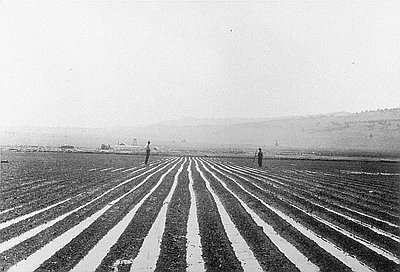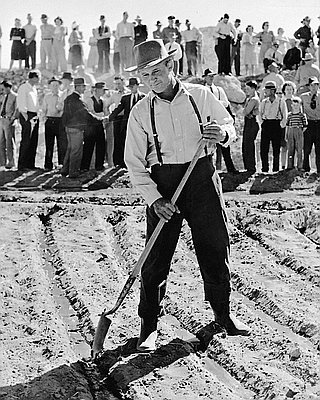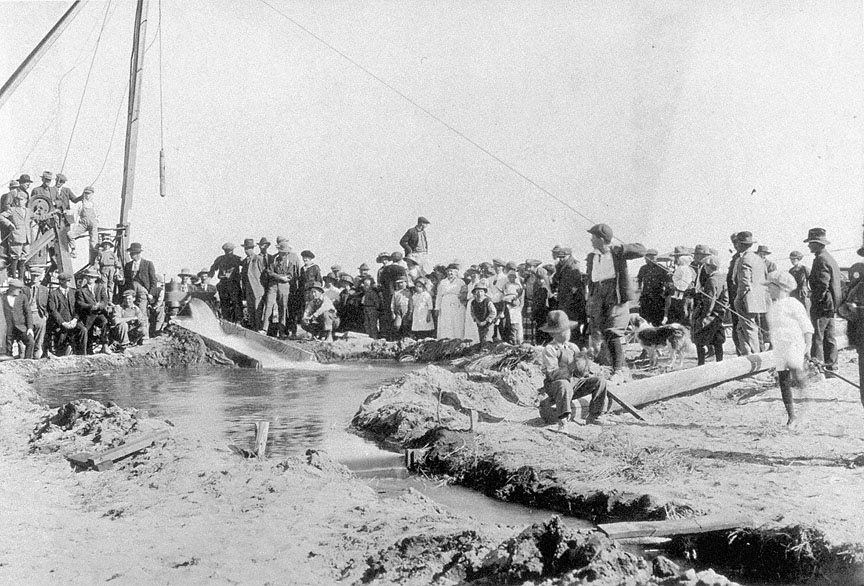- Catalog No. —
- OrHi 88558
- Date —
- October 6, 1921
- Era —
- 1921-1949 (Great Depression and World War II)
- Themes —
- Agriculture and Ranching, Environment and Natural Resources, Government, Law, and Politics
- Credits —
- Oregon Historical Society
- Regions —
- Central
- Author —
- Unknown
Demonstration of Ernst Well
In the early 1920s, the Oregon Bureau of Mines and Geology (OBMG) spent $40,000 drilling four test wells for water in the arid Fort Rock Valley. In the fall of 1921, the Portland N.C. Jannsen Drilling Company dug the first well on John and Beatrice Ernst’s farm near the town of Fort Rock. An October 6 public demonstration of the well attracted 150 people, who were also invited to celebrate at a community picnic and a dance. The Oregon Agricultural College established a demonstration plot on the Ernsts’ land the following spring, planting twenty acres of alfalfa.
OBMG director Henry M. Parks believed that the wells’ success proved there was a vast underground quantity of water in the Fort Rock Basin that could transform the area into fertile farmland. Valley residents hoped the state would also fund an extensive irrigation project. Instead, in 1923, Governor Walter M. Pierce eliminated the OBMG, and the project was never developed. Parks nevertheless continued to be optimistic about the farming potential of the Fort Rock Valley. He founded the Fort Rock Development Company, which bought the Ernst Farm test well from the state, and moved to the valley with his family in 1928. The Ernsts’ land became a promotional farm for the company and helped John Ernst build an elaborate, but inefficient, system of flumes and piping to transport water from a steam-powered well to the fields.
Ultimately, the Fort Rock Development Company was unable to attract more settlers to the region or to develop large-scale irrigation. Rabbits, low rainfall, alkaline soil, and soil erosion plagued valley farmers, and in the 1930s the federal government determined that farming was not practical in the Fort Rock Valley. The government bought out most of the remaining settlers and returned their land to the public domain.
Further Reading:
Merritt Y. “Bud” Parks, “The Fort Rock Basin: Valley in Transition.” Oregon Historical Quarterly 98, 1997: 56-84.
Allen, Barbara. Homesteading the High Desert. Salt Lake City, Utah, 1987.
Written by Kathy Tucker, © Oregon Historical Society, 2002
Related Historical Records
-
Rill-Type Irrigation, Parks Ranch
This 1928 photograph shows two men standing in an irrigated alfalfa field at Parks Ranch in the Fort Rock Valley, located in central Oregon’s high desert. The Fort …

-
Farmer Receives Deschutes Irrigation Project Water
This photograph shows George Rodman spreading irrigation water over his farmland near Culver on May 18, 1946. Rodman was the first farmer to receive water from the Deschutes Irrigation …

